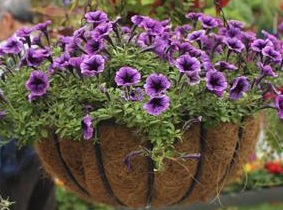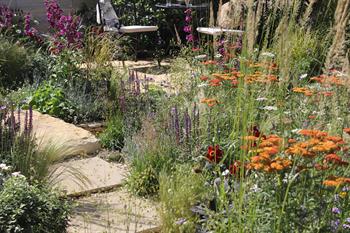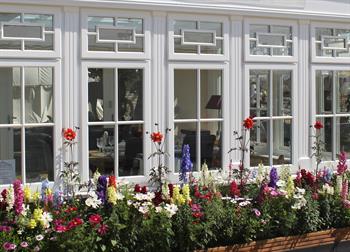Summer Flowering Plants | Garden Courses |Gardening Books

Many people opt to buy flowering bedding plants during the summer to add an instant splash of colour to their garden. Others prefer to plan ahead by choosing varieties of long-lived plants which will produce flowers at this time of year. If you think about this in early spring and plan ahead, then you should be able to continue the spring display well into summer and autumn too.
When deciding what to plant, it is useful to understand how long a plant takes to flower. Flowering time depends mainly on the plant variety, but also when you buy it and how you treat it. With a little knowledge and planning, you too can have a fabulous floral summer display.
Hints And Tips On Planting For Summer Colour
You could consider buying fast growing plants - plants that grow quickly will flower sooner. Be warned though, some fast growing plants can easily get out of hand if you don’t keep them in check. They are often garden thugs! Fast growing plants also tend not to live as long – regular pruning helps to extend longevity though.
Why not think about growing annuals? One of the easiest ways to add colour to your garden is to grow short-lived plants that will produce their flowers within a few weeks. Most annual flowering plants such as petunias and pansies will continue flowering for weeks and even months if they are regularly fed with liquid fertiliser. For a summer display you need to plant them in early to mid-spring, so now is a great time to do that.
Buy plants with flower buds in late spring– you can then be assured that the plants will be flowering by early summer.
Think about buying bigger plants - larger specimens will put more of their stored energy into flowering. They may cost a bit more but you will get an almost instant result.
Sometimes when we plant in spring it is easy to forget that temperatures can be variable - cold one day and hot the next. Make sure you protect your newly purchased plants from these extreme conditions that can cause bud and leaf drop (losing the flowers you were looking forward to). It is easy to stress out plants that are accustomed to controlled nursery conditions. So avoid planting them in the middle of a hot day.
Buy plants that have extended flowering periods – that is, those that hold on to their flowers for a long time.
Do a bit of research before buying, look at the labels so that you know the flowering time or do a quick ‘Google’ if you see something you like before buying it. Most plants only have a limited flowering season. Don’t get caught out buying a plant that won’t flower until later in the year, if you are looking for summer colour. Don't buy a plant that is already in flower now, but will be finished by the time summer arrives.
You can also consider planting seeds in early spring for summer flowers, if you live in a frost free area, then you may be able to plant seeds straight into the ground once the soil warms up a bit. If the soil feels cold to the touch, it is too cold to plant your seeds.
"If you want colour in your garden quickly, you need to know when the flowers will appear. If you are in doubt, ask at your local nursery or garden centre."
Flowers for When You are Using the Garden More
For those plants already in the garden such as hydrangeas, azaleas and roses, you can optimise the chances of abundant flowers for the festive season in summer by improving their growing conditions during spring – so now is a great time to start.
From early spring on use a multi-purpose fertiliser around the root zone and apply a liquid fertiliser every fortnight. Remove any weeds around the plants, and keep them well watered.
During spring your garden life is bursting with energy and so are those pest insects! Flowers can be ruined if the buds or foliage are damaged, so keep an eye out for any pest and disease problems. Be careful when using sprays though as these can sometimes discolour the foliage and flowers. You can avoid a lot of fungal problems by keeping water off the buds as it can promote the growth of fungal diseases.
Many plants, particularly shrubs, take much longer to develop a good crop of flowers. However, you may be able to purchase advanced specimens of plants like hydrangeas that flower by late spring or early summer. Look for healthy plants in spring and as soon as you get them home, plant them into a well-prepared bed in a sunny but sheltered position.
"The same plant species may flower at slightly different times of year in different parts."
Summer- Flowering Shrubs
 Abelia - deciduous or semi-evergreen shrubs which produce pinkish white through to mauve flowers over summer.
Abelia - deciduous or semi-evergreen shrubs which produce pinkish white through to mauve flowers over summer.
Abutilon - evergreen shrubs or small trees with funnel-shaped flowers. Some summer bedding species are also available.
Azalea (Rhododendron varieties) – these are small shrubs with profuse pink, white, red or mauve flowers. They are suited to mild areas. Prune after the spring flowering for a summer flush.
Butterfly Bush (Buddleia davidii) – large shrub with purple, white or pink spikes; may still be flowering in cooler areas.
Bottlebrush (Callistemon varieties) – a long-flowering group of shrubs with red, white, pink, mauve, or yellow flowers.
Fuchsias – many varieties with colourful bell-shaped flowers.
Gardenias – richly scented small white flowers; for mild areas.
Grevilleas – some cultivars flower nearly all year round; flowers are spidery or brush-shaped.
Kunzia baxteri – native shrub with bright red ‘bottlebrush’ flowers on short stems.
NSW Christmas Bush (Ceratopetalum gummiferum) – small tree or shrub for warmer areas; colourful red bracts produced over the Christmas period.
Rock Rose (Cistus) - evergreen shrubs which produce single rose-like flowers over several months. They prefer warm temperate regions.
Lavenders – these are evergreen shrubs with fragrant flowers and scented foliage.
Proteas – South African shrubs with interesting long-lasting blooms.
Roses – many varieties have summer flushes or produce sporadic flowers throughout the growing season.
Summer-Flowering Bulbs
Alstroemerias – comes in a wide variety of bright colours. Short and long stem varieties.
Arum lilies – large trumpet shaped flowers on long stems. Beware, the flowers are toxic.
Christmas Bells (Blandfodia) – Australian shrubs which produce pink or red trumpet-shaped flowers.
Christmas Lily – white trumpet-shaped flowers around Christmas.
Gladioli – produces long flower spikes in a variety of colours. The flowering time depends upon the individual species.
Gloxinias (Sinningia speciosa) - tender plant with velvety leaves and bell-shaped flowers. It is suited to warmer climates.
Kangaroo Paws – many varieties are still flowering at winter time.
Liriope - produce slender stems of purplish-lilac, hyacinth-like flowers.

Summer-Flowering Annuals and Perennials
Baby’s Breath (Gypsophila) - produces lacy fine stems with tiny white or pink flowers. They are often used in cut flower arrangements.
Cosmos – A tall annual with open feathery foliage and white, pink, orange or yellow flowers.
Gazania - Perennials in warmer regions, annuals in cold temperate zones. They have daisy-like flowers which close in the evening.
Geranium - herbaceous perennial species which grow with little watering or attention. Some are frost tender so make sure they are protected during those late spring frosts.
Globe amaranth – these produce small purple, red, pink or white globe flowers.
Honesty – Shade-loving annual with white or purple flowers followed by interesting silvery seed pods.
Marigold (both French Marigolds and Pot Marigold) these have yellow or orange daisy-like flowers.
Salvia – the stalwart of the summer garden – there is an abundant variety of cultivars available of these wonderful and colourful easy to grow plants.
Shasta daisy (Chrysanthemum maximum) - These have large single white flowers with a yellow centre. Many varieties exist. They are great for cut flowers.
Spider Flower – tall plants with unusual pink or white flowers.
Sunflowers – tall plants with showy yellow flowers.
You may also be interested in....
The Ultimate course for Home Gardeners - Be the "expert" in your family, or with your friends.
View Course